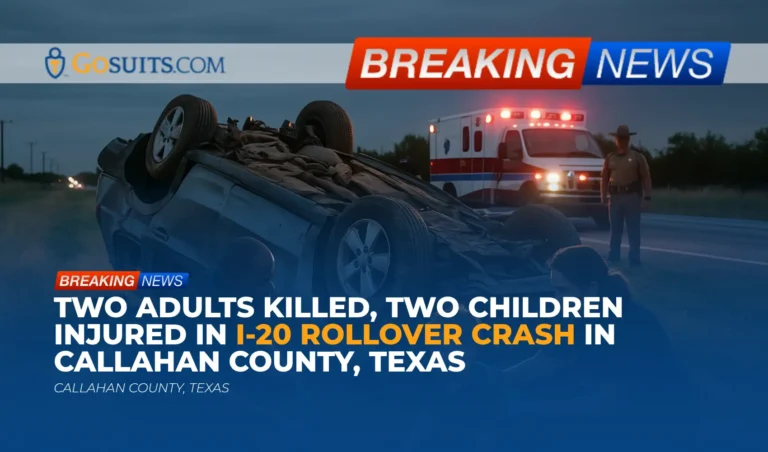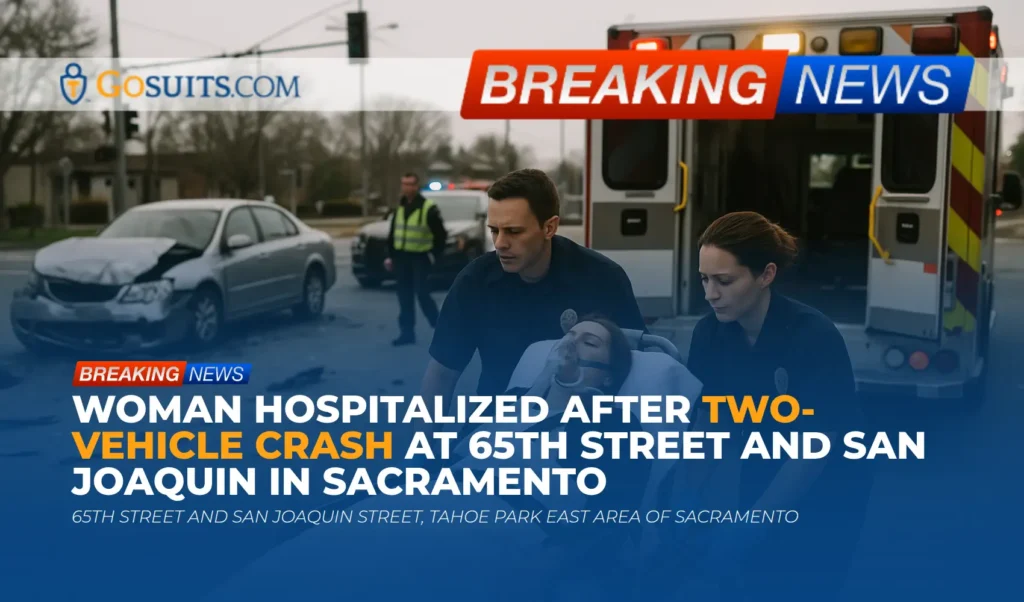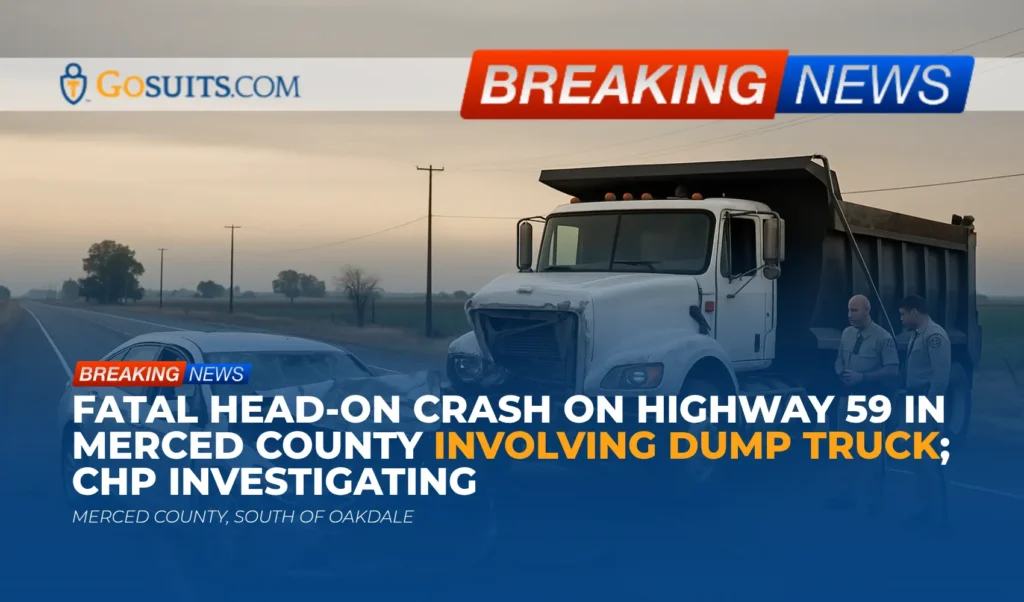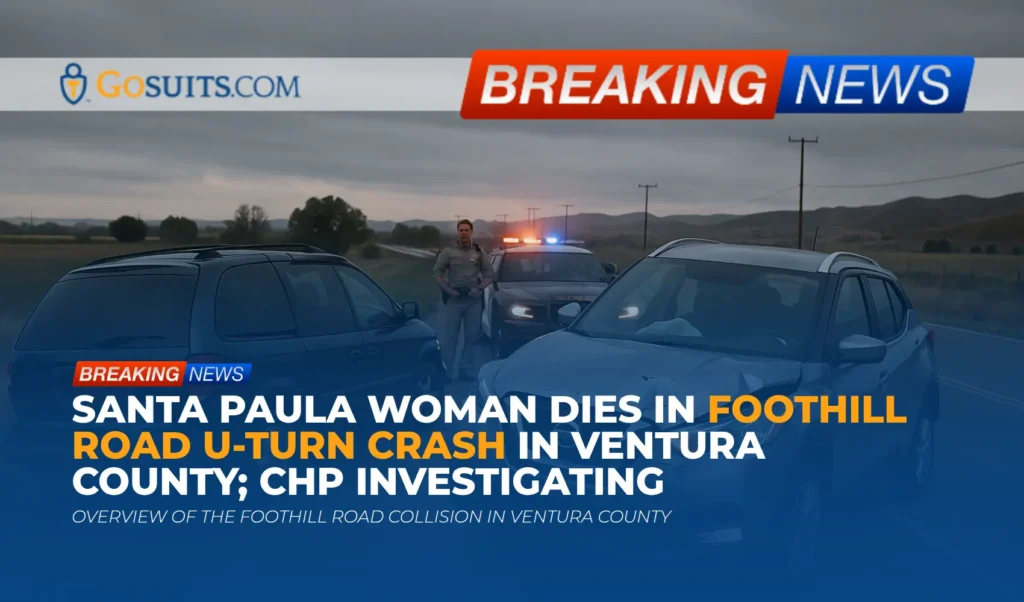- What happened on I-20 in Callahan County
- Where and when the crash occurred, and who responded
- Why rollovers and ejections are so dangerous
- Seat belts and child restraints in Texas, laws and safety science
- Potential civil claims and insurance pathways after a single-vehicle rollover
- Documents and records families may need, and where to request them
- Preserving evidence and protecting rights after a serious crash
- How insurance companies approach these cases
- Following official updates
- Commentary from Gosuits Callahan County, Texas Personal Injury Attorney
- Why timely action matters now
What happened on I-20 in Callahan County
Two adults tragically lost their lives and two children were injured in a single-vehicle crash on Interstate 20 in Callahan County on Monday night. According to a Texas Department of Public Safety news release summarized by local media, the crash occurred just before 10 p.m. near mile marker 319. The driver, identified as a 27-year-old woman from Midland, lost control of her SUV, left the roadway, and overcorrected. The SUV rolled multiple times. Both adult occupants were ejected and pronounced dead at the scene. Two children were injured, one seriously. Both children were transported for hospital care. Investigators stated that the adults and the child with serious injuries were not restrained at the time. A younger child riding in a rear-facing car seat suffered minor injuries. No other vehicles were involved.
Our hearts go out to the families, friends, and community members affected. The details released so far indicate a devastating rollover with occupant ejection. While investigations take time, families can begin gathering information, securing records, and understanding available civil remedies. The sections below explain what is publicly known, as well as practical steps and legal context that can help those navigating the aftermath of a fatal or serious-injury crash in Texas.
Where and when the crash occurred, and who responded
The incident happened on I-20 near mile marker 319 in Callahan County, Texas, just before 10 p.m. on a Monday evening. The Texas Department of Public Safety is identified as the primary investigating agency, consistent with its role in highway crash investigations statewide. Local emergency medical services and county authorities also typically respond in coordination with DPS to provide on-scene care, traffic control, and preliminary documentation.
In Texas, DPS troopers typically prepare the official peace officer’s crash report, often referred to as the CR-3. That report usually includes crash diagrams, narrative observations, contributing factors, and information on restraint use when determinable. Families can obtain this report through the Texas Department of Transportation’s Crash Records Information System after it is finalized, which can take days or weeks depending on the complexity of the investigation. Details on obtaining crash reports are included later in this article with links to official resources.
Why rollovers and ejections are so dangerous
Rollover crashes can be violent events that rapidly change motion and subject occupants to high forces. During a rollover, occupants who are not buckled are at significant risk of being ejected. Ejection dramatically increases the likelihood of severe injury or death. National Highway Traffic Safety Administration materials explain the particular dangers of rollover crashes and the lifesaving potential of restraints and modern vehicle safety systems, including ejection mitigation technologies. For general rollover information, see NHTSA’s rollover safety page.
Seat belts and appropriate child restraints reduce the risk of fatal injury and the risk of ejection. Public health data consistently shows that wearing a seat belt substantially reduces the risk of dying in a crash. The Centers for Disease Control and Prevention summarizes that seat belts reduce serious crash-related injuries and deaths among front-seat passengers by about half. For verified data, see CDC’s seat belt safety page. For children, rear-facing and forward-facing car seats, as well as booster seats, greatly lower the risk of serious injury when used correctly. CDC provides evidence-based guidance on child passenger safety at CDC Child Passenger Safety.
While every crash is unique, the pattern described by investigators here, a loss of control, overcorrection, and rollover, aligns with scenarios in which unrestrained occupants are vulnerable to ejection. Investigations can later explore whether factors such as roadway conditions, vehicle handling, tire or component issues, speed, environmental conditions, or other contributors played any role. The presence of a properly used rear-facing car seat correlating with minor injury to the younger child matches established research on the protective value of appropriate child restraints.
Seat belts and child restraints in Texas, laws and safety science
Texas law requires adult occupants to use seat belts when they are equipped in a vehicle. Texas Transportation Code section 545.413 sets out general seat belt use requirements. You can review the statute at Texas Transportation Code 545.413. Texas law also requires proper child passenger safety restraints according to the child’s age, height, and weight, and requires rear-facing use for infants consistent with manufacturer instructions. See Texas Transportation Code 545.412.
Safety research from federal health agencies reinforces the effect of seat belts and child restraints:
- Seat belts save lives. The CDC reports that consistent use of seat belts reduces the risk of death and serious injury for adults in passenger vehicles. See CDC Seat Belt Safety.
- Child restraints are critical. The CDC summarizes that appropriate car seats and booster seats reduce the risk of serious injury for children in crashes. For recommendations and data, see CDC Child Passenger Safety.
Even when a vehicle rolls over, a correctly worn seat belt and a properly installed, age-appropriate child seat can prevent ejection and mitigate injuries. Proper use is essential, including correct installation, correct harness fit, and adherence to weight and height limits. Local fire departments, hospitals, and state-certified inspection stations often offer child seat checks. The Texas Department of Transportation’s safety programs periodically host free fitting stations and events statewide.
Potential civil claims and insurance pathways after a single-vehicle rollover
When a crash involves only one vehicle, families sometimes assume there is no civil claim. That is not always the case. In Texas, several potential civil pathways may exist depending on the facts, including claims by injured passengers, wrongful death claims by statutory beneficiaries, survival claims on behalf of the estate, and coverage under various auto insurance components. The following points are general educational information based on Texas law.
Passenger injury claims
Passengers who are injured in a crash may bring claims against the at-fault driver’s liability insurance. Liability policies are designed to cover injuries and losses caused by the negligence of the insured driver, including injuries to passengers. Determining fault can be complex in single-vehicle rollovers and may involve analysis of driver inputs, roadway conditions, vehicle integrity, and other factors. An early, thorough review can help clarify responsibility, the available coverage, and how to document damages.
Wrongful death and survival claims
Texas law allows certain family members to bring wrongful death claims when a death is caused by a wrongful act, neglect, carelessness, unskillfulness, or default. These claims are governed by Chapter 71 of the Texas Civil Practice and Remedies Code. You can review the statutory framework at Texas Civil Practice and Remedies Code Chapter 71. A related cause of action, the survival claim, allows the decedent’s estate to recover damages the decedent could have recovered if they had survived. The interaction between wrongful death and survival claims depends on the circumstances and the available insurance or other responsible parties.
Potential third-party liability
Though no other driver was involved, other potential contributors can sometimes be examined. Examples can include defective vehicle components, tire failures, or hazardous road conditions. These theories require careful investigation and often technical analysis. While such allegations are case-specific, understanding possible third-party involvement ensures that potential claims are not overlooked.
Statute of limitations
Texas generally imposes a two-year statute of limitations for personal injury and wrongful death actions, measured from the date of injury or death. This deadline is set out in Texas Civil Practice and Remedies Code section 16.003, which can be reviewed at CPRC 16.003. Certain exceptions or different timelines may apply in specific scenarios, so early legal guidance is important to avoid missing a filing deadline.
Texas Tort Claims Act considerations
If a claim involves a governmental unit, such as issues related to roadway maintenance or design, separate notice requirements, damage caps, and other limitations may apply. These are addressed by the Texas Tort Claims Act, which can be reviewed at CPRC Chapter 101. The relevance of this law depends entirely on the facts uncovered during investigation.

Documents and records families may need, and where to request them
Obtaining accurate official records helps families understand what happened and supports insurance and civil claims. In Texas, several key records may be available through state and county agencies.
Peace Officer’s Crash Report and related records
- CR-3 crash report. Obtain the official crash report through the Texas Department of Transportation’s Crash Records Information System. The portal explains eligibility and availability. See TxDOT CRIS Crash Reports.
- Supplemental materials. Photographs, measurements, and additional DPS documentation may exist. Availability and process can vary. TxDOT’s page provides general guidance, and DPS may have related records depending on the investigation. Start with the CRIS portal and follow the instructions provided.
Autopsy, inquest, and death certification
- Inquest authority. In Texas counties without a medical examiner system, the Justice of the Peace conducts inquests into certain deaths, including those resulting from crashes. This is set out in the Texas Code of Criminal Procedure, Chapter 49. See Texas CCP Chapter 49.
- Autopsy and inquest records. Depending on the county and circumstances, the JP or medical examiner may oversee autopsies and inquest records. Families can contact the appropriate county office to learn whether records are available and the process to request them. Availability can be affected by open investigations and confidentiality laws.
- Death certificates. Certified copies of death certificates can be ordered through the Texas Department of State Health Services Vital Statistics Section. See Texas DSHS Death Records.
Medical records and billing
Hospitals and treating providers maintain records of care provided to injured occupants. Families may request records and billing statements through provider medical records departments. If a minor is injured, a parent or legal guardian typically requests records on the child’s behalf. These records are important for documenting the nature and extent of injuries and medical expenses.
Vehicle and event data recorder information
Many modern vehicles record certain data during a crash event, such as speed, braking, and seat belt status. This event data recorder, sometimes called a black box, can be critical evidence. Federal rules address EDR data elements and manufacturer obligations, see 49 CFR Part 563, and NHTSA provides an overview at NHTSA Event Data Recorder. Preserving the vehicle and preventing alteration of its systems is important when EDR data may be relevant.
Preserving evidence and protecting rights after a serious crash
Evidence can be lost quickly after a rollover, especially when a vehicle is towed, repaired, salvaged, or disposed of. Steps that often help protect information include:
- Secure the vehicle. Notify the storage facility or insurer in writing not to destroy or alter the vehicle until inspections are complete, including potential downloads of EDR data.
- Photograph and document. If possible, photograph the vehicle interior and exterior, any child seats and their installation, road conditions near the crash site, and tire condition. Keep copies of all tow slips and storage invoices.
- Identify witnesses. Record names and contact information for any witnesses or first responders who may have relevant observations.
- Maintain all records. Keep all hospital records, discharge summaries, imaging reports, and billing statements. Maintain receipts for out-of-pocket expenses, mileage to medical appointments, and caregiving or childcare costs.
- Avoid public statements. Social media posts can be taken out of context. Consider avoiding public commentary about the crash until matters are resolved.
- Consult a qualified attorney before speaking with insurers. Early guidance can help prevent missteps. Recorded statements and written forms can affect later claims.
How insurance companies approach these cases
Auto insurers assess liability, coverage limits, and damages promptly after a crash. Common coverages in Texas include bodily injury liability, property damage liability, personal injury protection or medical payments coverage, and sometimes uninsured or underinsured motorist coverage. The Texas Department of Insurance provides a consumer guide to auto insurance coverages at TDI Auto Insurance Guide.
Important considerations in serious-injury and fatal crashes include:
- Liability coverage for passengers. Passenger injury and death claims may be made against the driver’s liability coverage, subject to policy limits. Multiple claimants can complicate distribution of limited benefits.
- PIP or MedPay. Personal injury protection or medical payments coverage, if purchased, can help with medical expenses regardless of fault, up to policy limits. Policies vary.
- UM or UIM. Uninsured or underinsured motorist coverage is typically implicated when a negligent at-fault party lacks sufficient insurance. In a single-vehicle crash, UM or UIM generally may be less central unless other at-fault parties exist, such as an unknown hit-and-run or a third party later determined to be responsible.
- Recorded statements. Insurers often request recorded statements. What a claimant says can be used later to limit or deny claims. It is prudent to consult an attorney before providing statements or signing authorizations.
- Health insurer and hospital liens. Texas law allows certain medical providers to assert liens for accident-related care. Managing liens and subrogation claims is part of resolving many serious injury and wrongful death matters. For statutory reference, see Texas Property Code Chapter 55 at Property Code 55.
Because insurers move quickly, early organization of documents and careful communication are essential. When in doubt, pausing and seeking legal guidance before responding to an insurer’s request is often the safer course.
Following official updates
Local media reported initial details based on a DPS release. Investigations can take time, and official narratives may be updated as evidence is analyzed. Formal crash reports are typically released through TxDOT’s CRIS system once finalized. Families seeking additional information can:
- Check for the official crash report using TxDOT’s CRIS portal when available.
- Inquire with the county inquest authority, which is either the county medical examiner or the Justice of the Peace, as authorized by CCP Chapter 49. Availability of records may depend on the status of the investigation.
- Request certified death certificates through Texas DSHS Vital Statistics for insurance and probate purposes.

Commentary from Gosuits Callahan County, Texas Personal Injury Attorney
First, deepest sympathies to every person affected by this crash. Losing loved ones and seeing children hurt is heartbreaking for any community. This article is intended for general education and information. It is not a substitute for individualized guidance about a specific situation.
Based on what has been publicly shared, the crash appears to involve a loss of control, overcorrection, and a rollover with ejection of unrestrained adult occupants. From a civil injury perspective, that combination is particularly dangerous because rollovers amplify forces and ejection often leads to catastrophic outcomes. The report that a rear-facing child seat helped prevent severe injury to the younger child aligns with well-established safety research and Texas law that underscores the importance of proper child restraints.
In single-vehicle rollovers, families sometimes assume that there is no avenue for recovery. In reality, several paths may exist, including passenger claims, wrongful death and survival actions, and, in some cases, potential third-party responsibility that is only uncovered after a thorough review of vehicle condition, tires, roadway characteristics, and data from the vehicle’s event data recorder. Timely preservation of the vehicle and electronic data, along with securing the official crash report and medical documentation, can make a meaningful difference in understanding what occurred and who bears responsibility.
Insurance companies are sophisticated organizations that act quickly. Adjusters may sound compassionate, yet their job includes minimizing claim payouts. They often request recorded statements and broad medical authorizations early on. Without preparation, people can inadvertently say things that are later used to question liability, discount injuries, or reduce damages. Early consultations help level the playing field by clarifying rights, insurance coverages, and the steps needed to protect claims. A no-cost consultation allows individuals to ask questions and understand options before dealing with insurers directly.
Why timely action matters now
The following guidance is provided to help the public understand why prompt, informed action is important after a serious crash:
- Secure official records quickly. Ordering the CR-3 crash report and requesting any available supplemental materials informs next steps and helps avoid reliance on incomplete information. Records can take time to process, and delays may slow insurance coordination or probate needs.
- Preserve critical evidence. Vehicles are often moved, repaired, or salvaged within days. Sending written preservation requests to storage facilities and insurers can prevent loss of the vehicle and its event data recorder information, photographs, and parts that may be essential to understanding causation.
- Avoid insurer statements before getting guidance. Recorded statements and broad release forms can affect outcomes. Consulting a seasoned attorney before speaking to any insurer helps prevent misunderstandings. Anything said to an insurer can be used to challenge or devalue claims later.
- Document all losses as they occur. Keeping a running log of medical visits, symptoms, time away from work, travel mileage, and out-of-pocket costs creates a reliable record that supports later claims and reduces disputes over what occurred.
- Understand time limits. Texas generally applies a two-year statute of limitations to personal injury and wrongful death claims, and special notice rules may apply if a governmental entity could be implicated. Early attention to deadlines prevents last-minute scrambles and preserves options.
- Coordinate benefits and liens early. Health insurance, auto medical coverages, and potential hospital or provider liens intersect in serious crashes. Sorting these issues early minimizes surprise bills and helps prevent avoidable delays in resolving claims.
- Use reputable sources for safety and legal information. Relying on official government guidance can reduce confusion and misinformation. State and federal resources linked in this article offer reliable information on crash reports, death records, seat belt laws, and child passenger safety.
- Consider a free legal consultation before making claims. A no-cost consultation can clarify responsibilities, coverage options, and next steps without committing to a course of action. This is especially important before contacting an insurance company about any claim.
Acting promptly helps preserve evidence, ensures access to accurate records, and reduces the chance that time-sensitive rights are lost. Early, careful steps make it more likely that insurance and legal processes proceed on a clear and documented foundation.
Additional legal and safety references
For those seeking primary sources on topics discussed above, the following government resources may be helpful:
- TxDOT Crash Records Information System, purchase official crash reports
- Texas DSHS, death records and certificates
- Texas Transportation Code 545.413, seat belt use
- Texas Transportation Code 545.412, child passenger safety
- Texas Civil Practice and Remedies Code, Chapter 71, wrongful death and survival
- Texas Civil Practice and Remedies Code 16.003, two-year limitations
- Texas Civil Practice and Remedies Code, Chapter 101, Tort Claims Act
- CDC Seat Belt Safety
- CDC Child Passenger Safety
- NHTSA Rollover Safety
- 49 CFR Part 563, event data recorders
- NHTSA Event Data Recorder overview
- Texas Department of Insurance, auto insurance consumer guide
- Texas Property Code Chapter 55, hospital liens
- Texas Code of Criminal Procedure Chapter 49, inquests by JP or medical examiner






